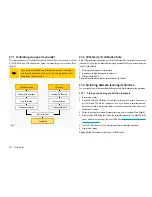
Safety Instructions |
13
15.2 Before commissioning
>
Before every flight, check the functional reliability of your model and the transmitter.
Watch out for any visible damage such as defective plug connections or damaged
cables and wires.
>
All moving parts of the model must run smoothly but should not have any play in their
bearings.
>
Before each operation check the correct and secure position of the propellers.
>
Charge the flight battery according to the steps provided in chapter
‘24. canopy’ on
page 23
. Ensure sufficient residual capacity [ battery tester (not included) ] of the
batteries inserted in the transmitter. If the batteries are empty, always replace the
complete set, never individual cells only.
>
Always switch on the transmitter first before connecting the battery to the »NovaX 350.
>
Set the throttle to zero before connecting the battery to the »NovaX 350. The rotors
(3)
might run unintentionally!
15.3 During Operation
>
When the rotors are running, make sure that neither objects nor body parts are in the
rotating and suction area of the propellers.
>
Do not take any risks when operating the model! Your own safety and that of your
environment is solely down to you being responsible when dealing with the model.
>
Improper operation may cause serious injury and property damage! Therefore make
sure to keep a sufficiently safe distance to persons, animals or objects during operation.
>
Select an appropriate location for the operation of the »NovaX 350.
>
Fly the »NovaX 350 only if your ability to respond is unrestricted. The influence of
tiredness, alcohol or medication can cause incorrect responses.
>
Do not direct your model towards spectators or yourself.
>
Motor, electronics and flight battery may heat up during operation. Wait 5 to 10 minutes
before recharging or replacing the flight battery.
>
Never switch off the transmitter while the »NovaX 350 is in use. After landing, always
disconnect the flight battery first. Only then may the transmitter be switched off.
>
In case of a defect or a malfunction, remove the problem before using the »NovaX 350
again.
>
Never expose the »NovaX 350 or the transmitter to direct sunlight or excessive heat for
an extended period of time.
>
In the case of a severe crash (e.g. from a high altitude) the electric gyro sensors can be
damaged and/or misadjusted. Therefore, full functionality must be tested before flying
again without fail!
>
In the event of a crash, the throttle should be immediately set to zero. Rotating
propellers may be damaged if they come into contact with obstacles. Before flying
again, these should be checked for possible tears or breakages!
>
Observe the warn/safety signals emitted by the »NovaX 350 at all times to avoid
damage (e.g. discharged battery).
15.4 Outdoor flying locations
>
Always and only operate the »NovaX 350 in a designated RC flying area.
>
Stay away from power lines, cellphone towers and other sources of potential
interference, and restricted areas.
>
Never fly the »NovaX 350 above people.
>
Contact a local RC club nearby to find out more about designated and approved flying
areas.
15.5 Batteries
15.5.1 General information
>
Correct polarity must be observed while inserting the batteries.
>
Remove the battery from the »NovaX 350 after every flight. Remove the batteries from the
transmitter if you do not use it for a longer period of time. Discharged batteries may leak.
Summary of Contents for NovaX 350
Page 1: ...88012RC ArF 88014RC RtF NovaX 350 Operating instructions M1...
Page 2: ...2 EVER WONDERED WHAT INNOVATION LOOKS LIKE NovaX 350...
Page 21: ...Dimensions 21 22 2 Long legs 283 mm 283 mm 250 mm 241 mm 130 mm 2 0 3 m m 3 4 7 m m...
Page 27: ...Calibration 27 2 1 90 90 90 1 2 3 4 5 6 Fig 6...
Page 49: ...49...
Page 50: ...50...
Page 51: ...51...
Page 52: ...52 www rclogger com...











































